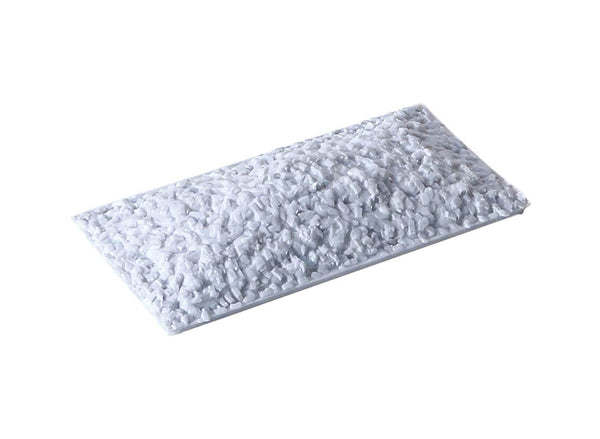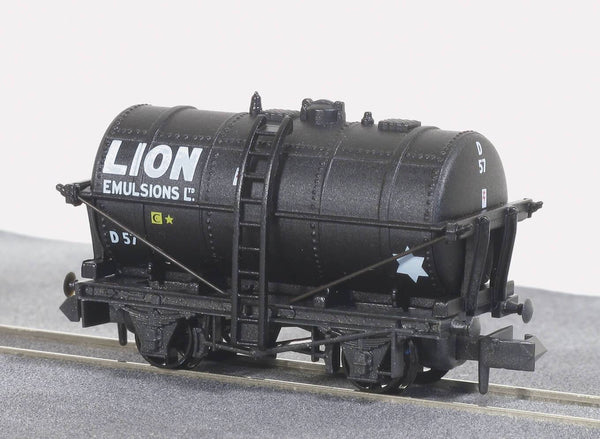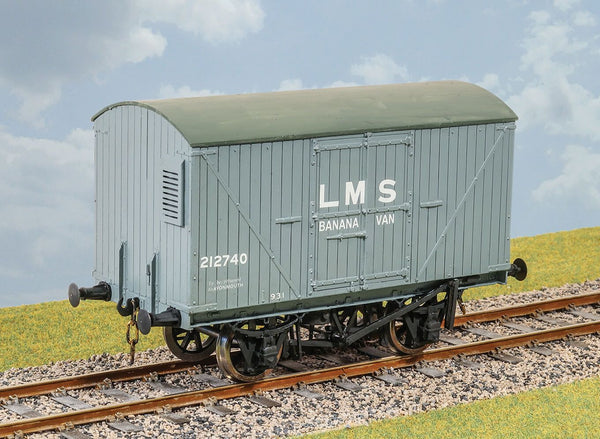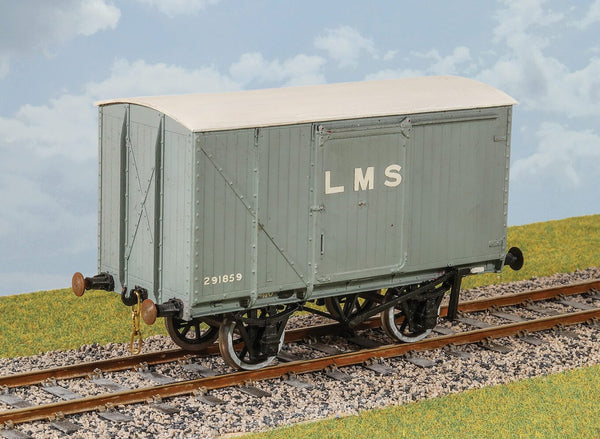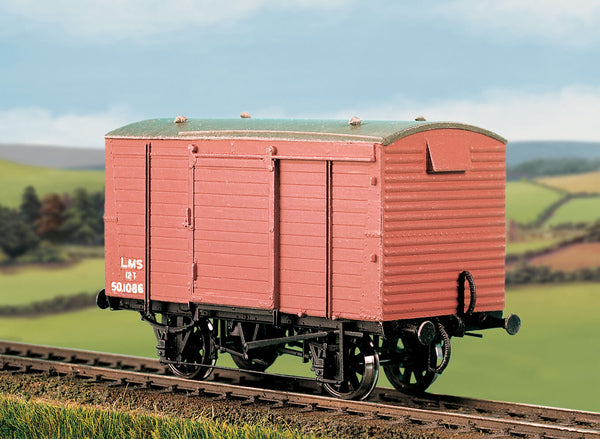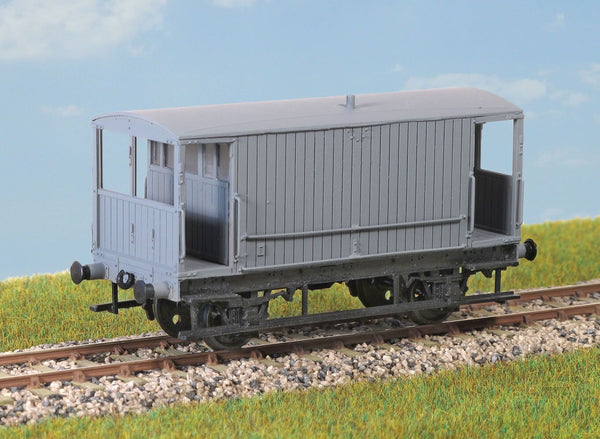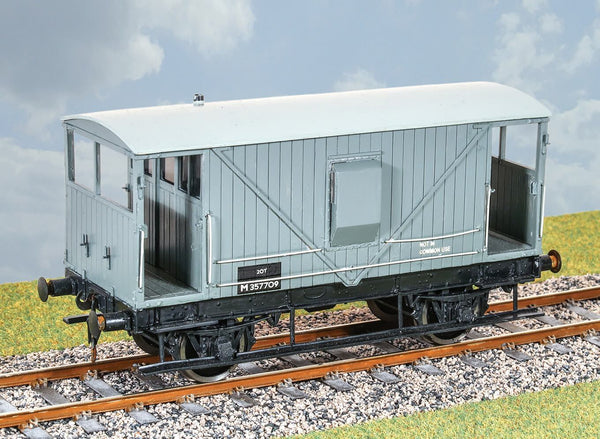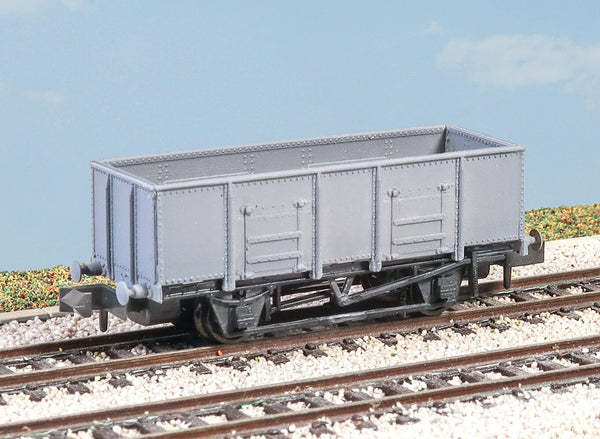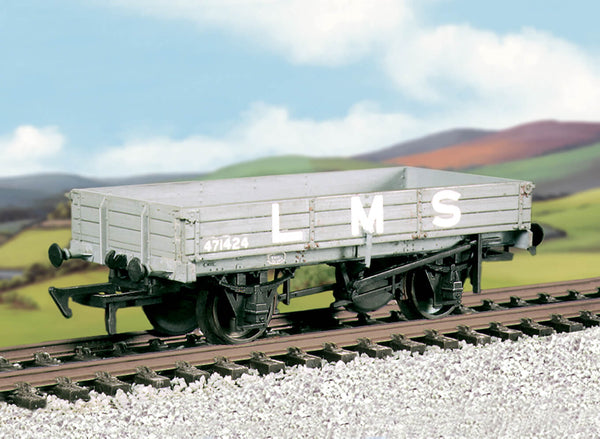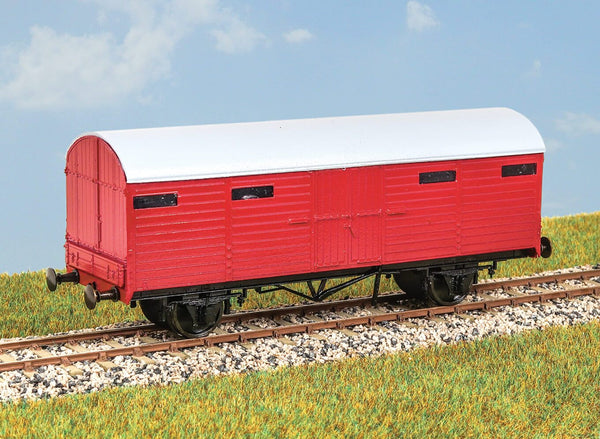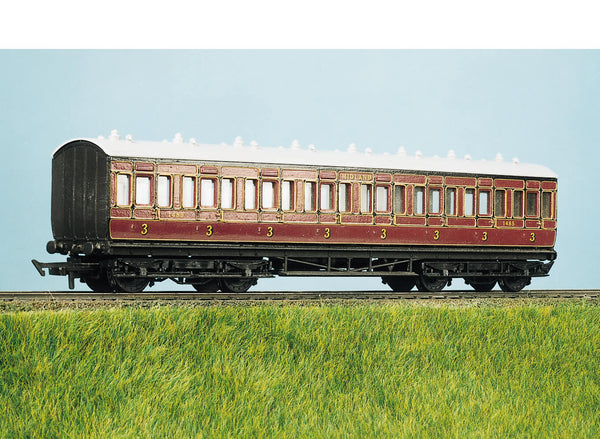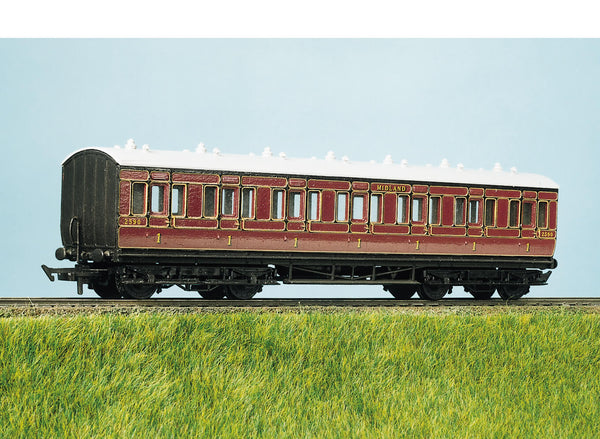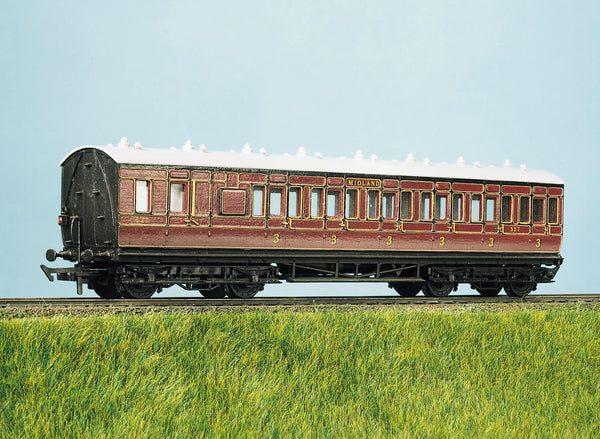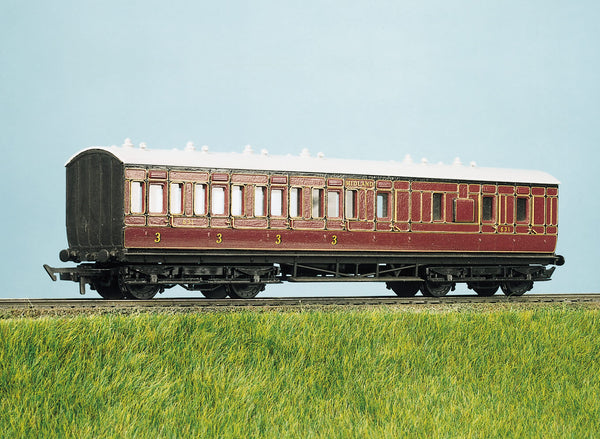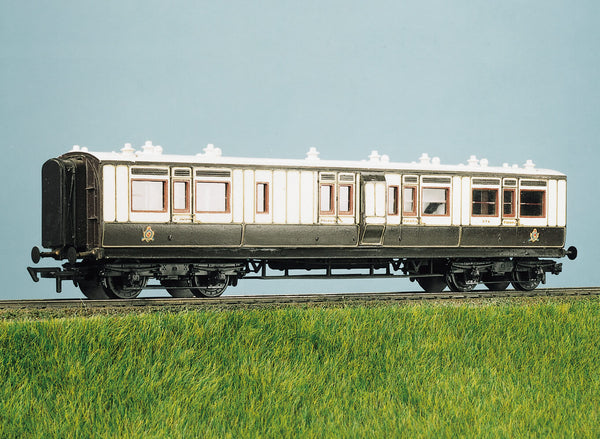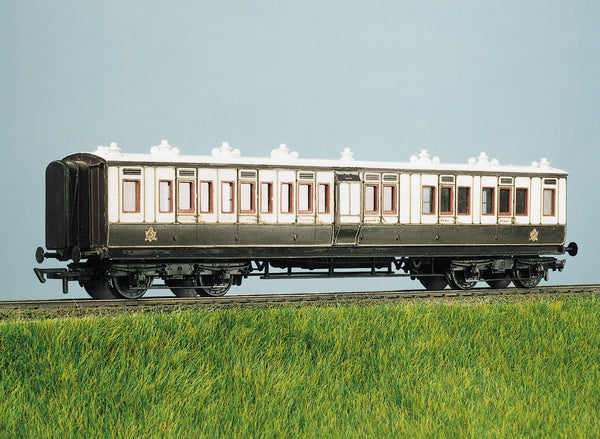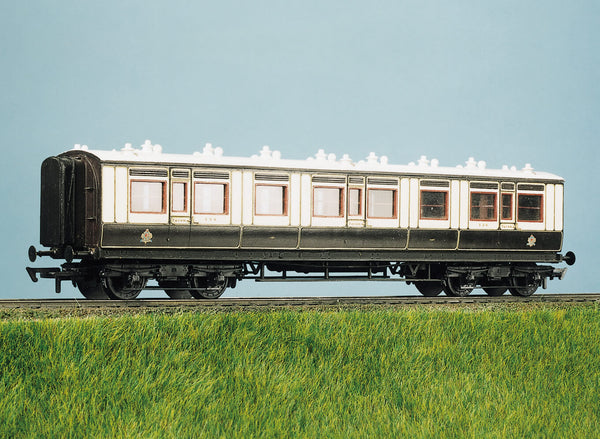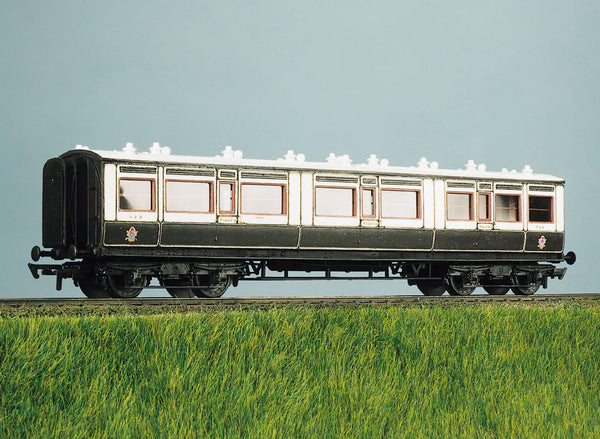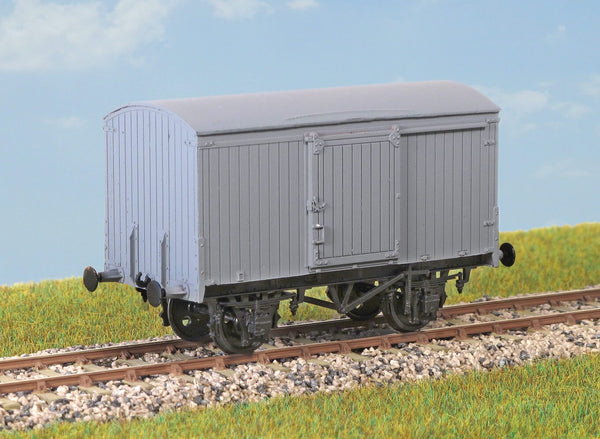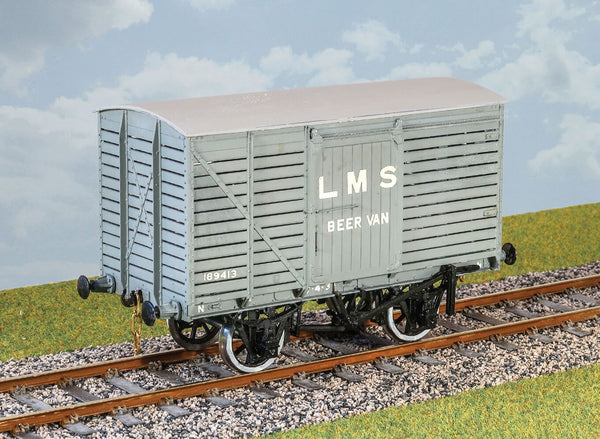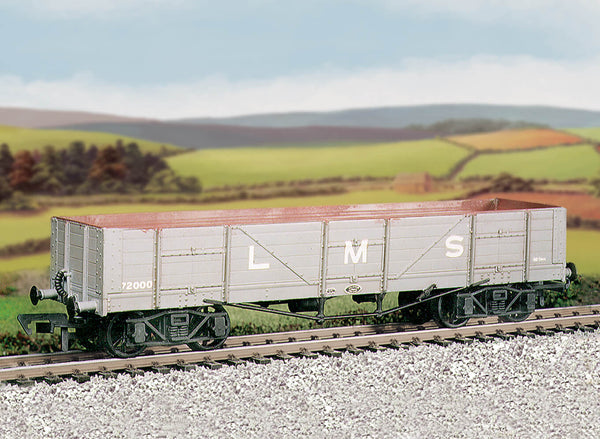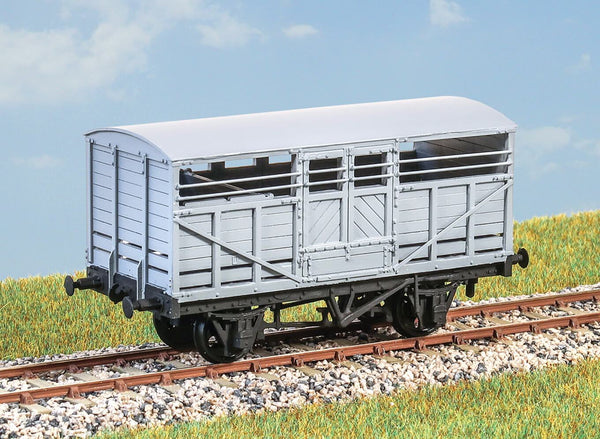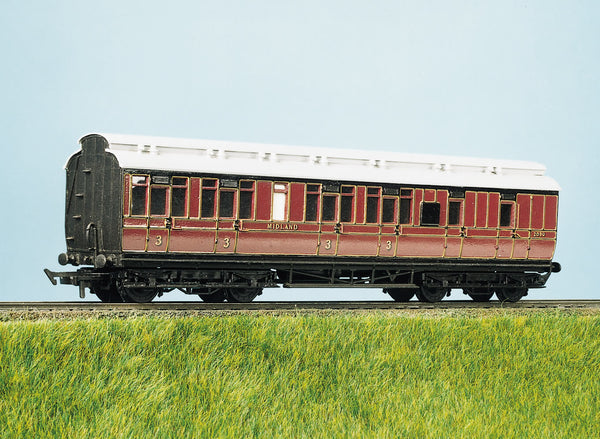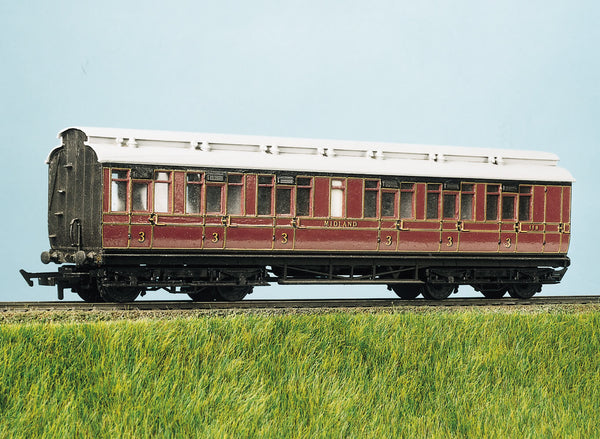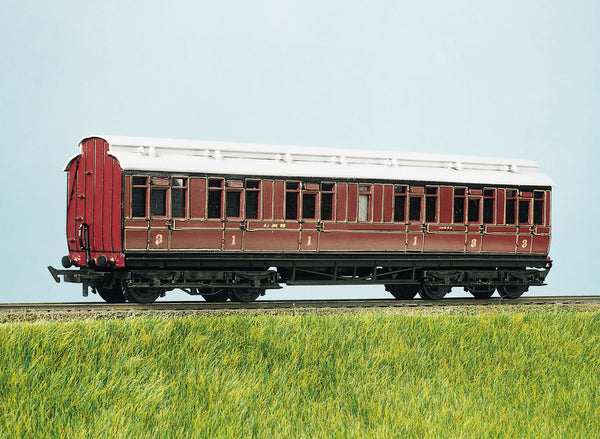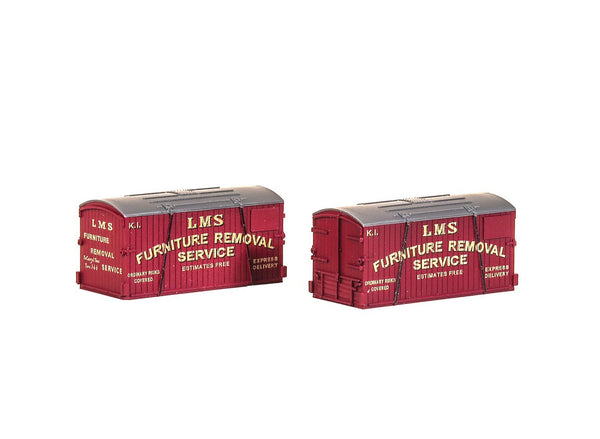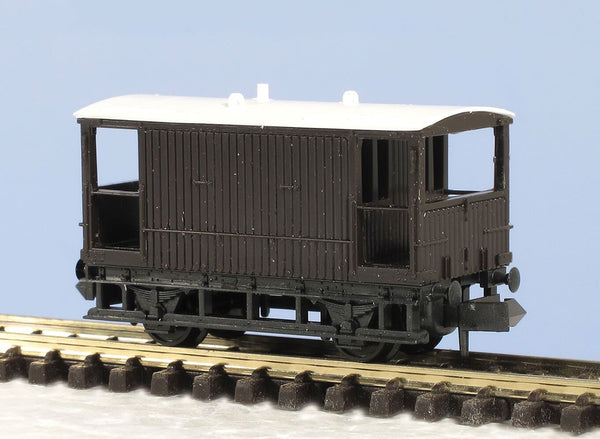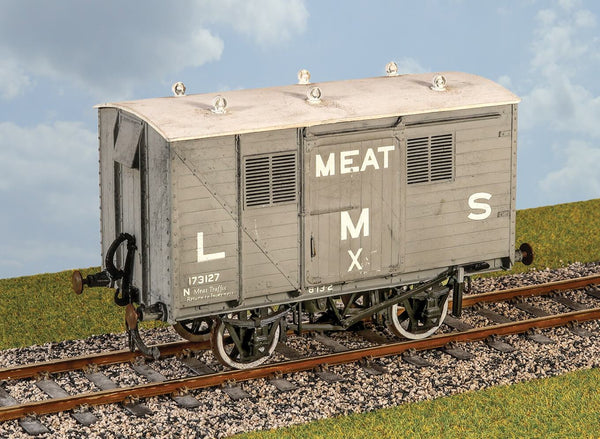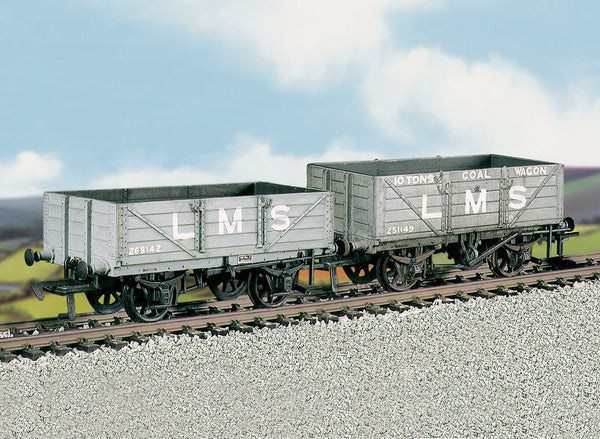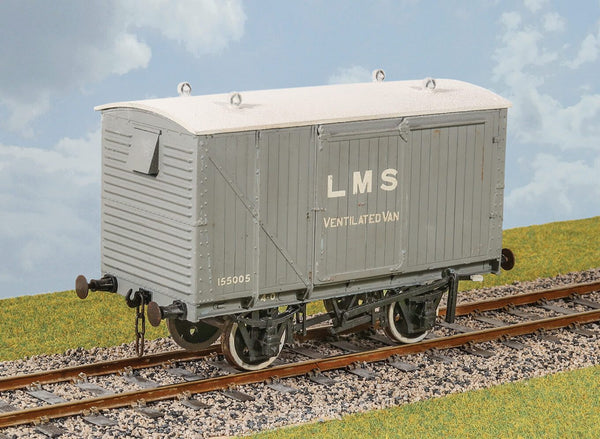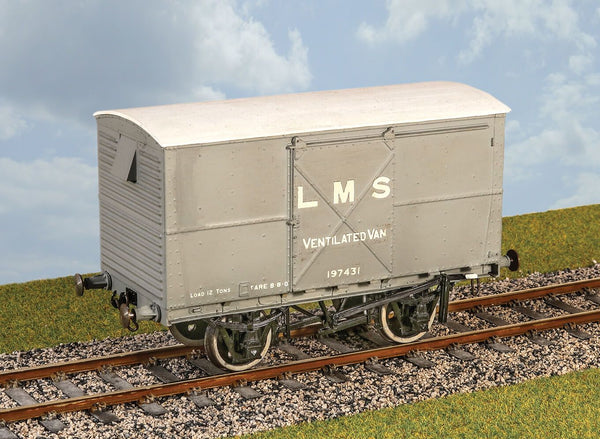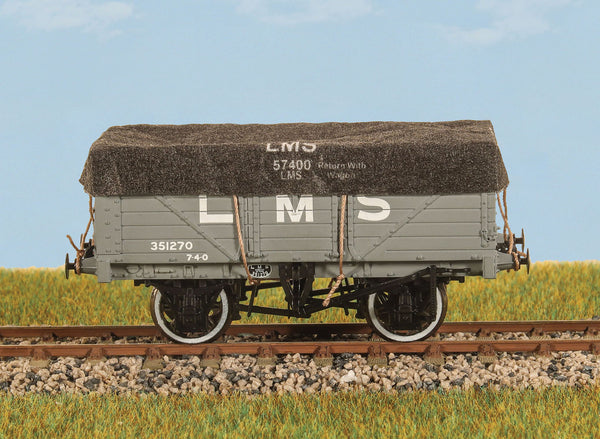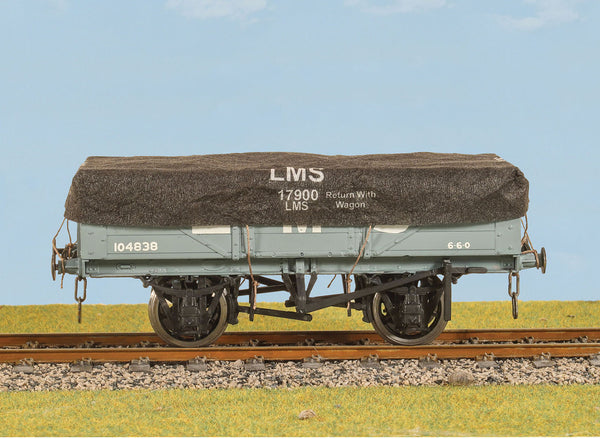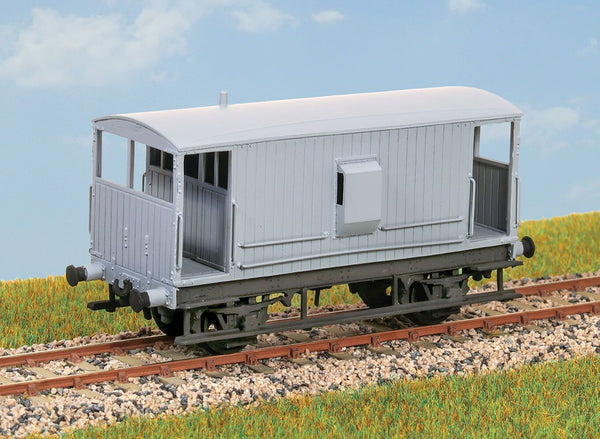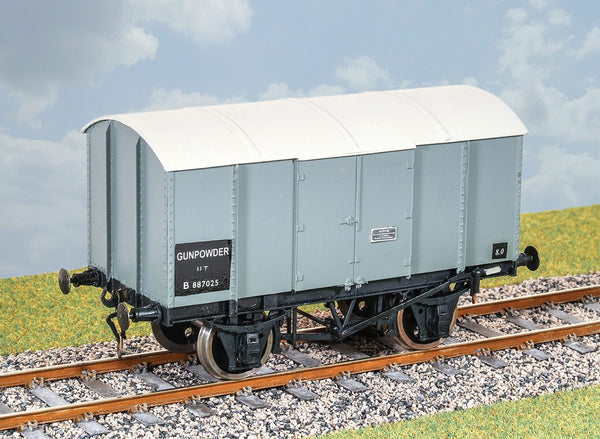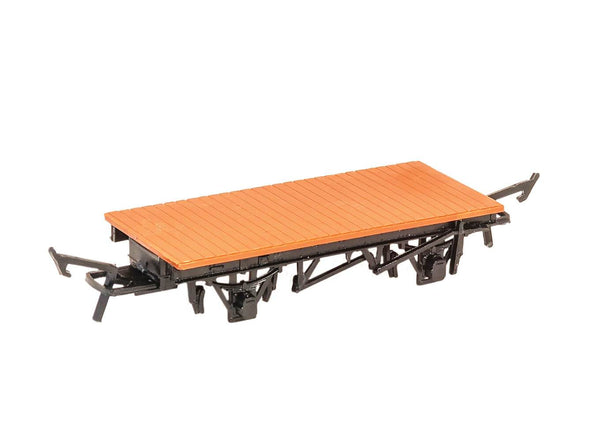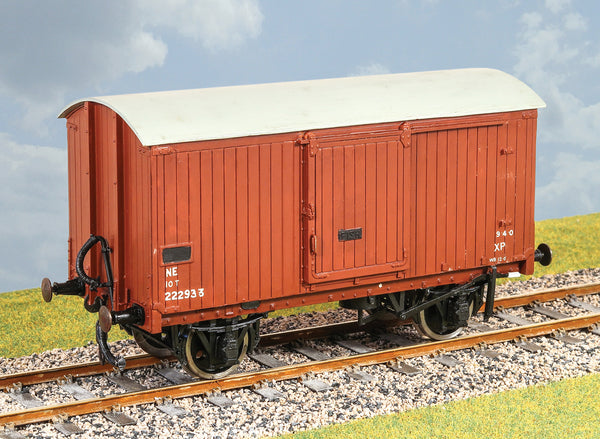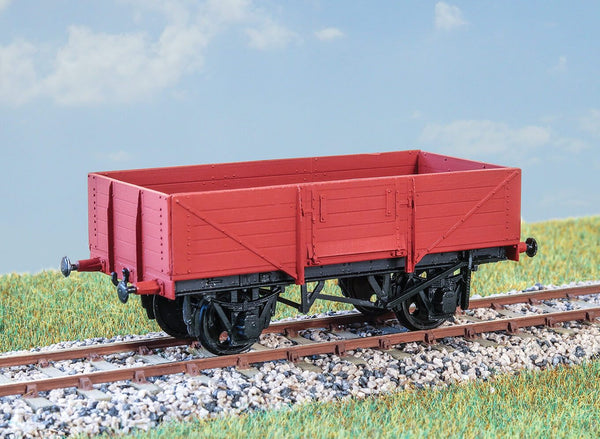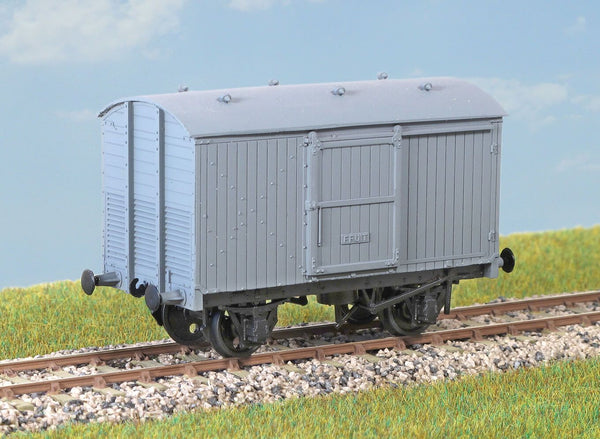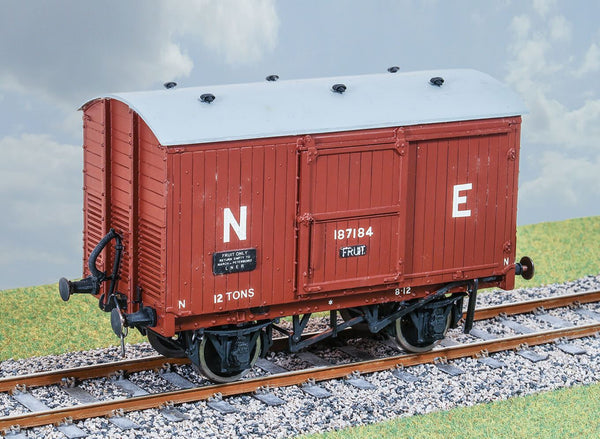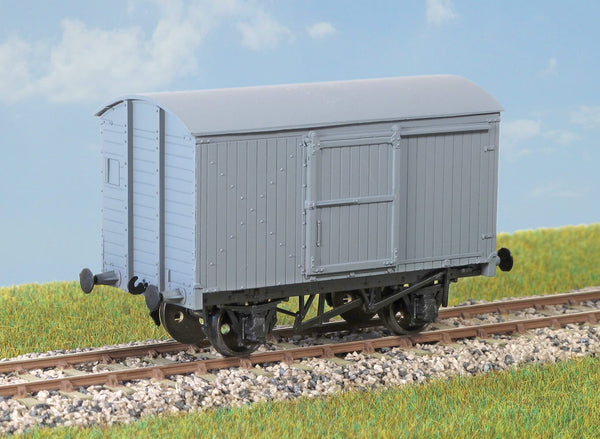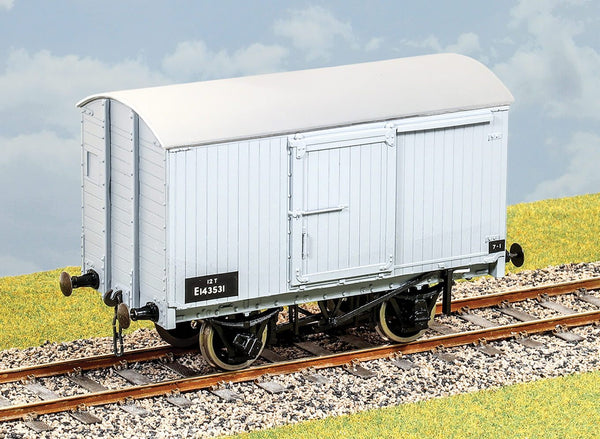BROWSE PECO PRODUCTS
Browse through our complete product portfolio.
740 Products Found
Lion Emulsions Tank Wagon
Private owner wagons abounded prior to nationalisation, they would often be seen far from their base as they were sent to collect raw materials and supplies such as coal, and deliver finished goods. All Peco wagons feature free running wheels in pin point axles. The ELC coupling, whilst compatible with the standard N gauge couplings, keeps a realistic distance between vehicles and enables the PL-25 electro magnetic decoupler to be used for remote uncoupling.
LMS 10ton Banana Van
1,000 of these vans were built between 1925 and 1930 to carry ripening bananas from ports to inland warehouses. They were steam heated by means of through pipes from the locomotive. The steam heating equipment was later removed, but the vans lasted into the 1960s. Transfers for LMS and BR. These finely moulded plastic wagon kits come complete with pin point axle wheels and bearings, 3 link couplings and transfers. This kit is supplied with pre-coloured moulded parts although painting can improve the appearance. Additional parts to enable the vehicle to be modelled incorporating modifications made to the prototypes during their working life are included where appropriate.
LMS 12ton Open Goods Wagon
8,500 of this type were built in the 1920s for carrying general goods traffic. It is a Midland Railway-derived design with a steel chassis. As they were classified “common user” they would turn up anywhere on the railway network. Transfers for LMS and BR. These finely moulded plastic wagon kits come complete with pin point axle wheels and bearings, 3 link couplings and transfers. This kit is supplied with pre-coloured moulded parts although painting can improve the appearance. Additional parts to enable the vehicle to be modelled incorporating modifications made to the prototypes during their working life are included where appropriate.
LMS 12ton Van
Built by the LMS, who produced over 2,500 in 1924 – 1926. Midland Railway design with 9-foot steel chassis. Lasted until the early 1960s. Transfers for LMS and BR. These finely moulded plastic wagon kits come complete with pin point axle wheels and bearings, 3 link couplings and transfers. This kit is supplied with pre-coloured moulded parts although painting can improve the appearance. Additional parts to enable the vehicle to be modelled incorporating modifications made to the prototypes during their working life are included where appropriate.
LMS 12ton Ventilated Box Van Kit
20,000 of this simple, workmanlike design were built between 1934 and 1944 for carrying perishable goods. Transfers are included; glue and paints are required to complete this model.
LMS 20ton Goods Brake Van
849 of these vans (diagram 1659) were built between 1924 and 1927. In general traffic they survived into the 1960s, while those in Engineer’s fleet lasted into the 1980s. These finely moulded plastic wagon kits come complete with pin point axle wheels and bearings. Glue and paint will be required, along with appropriate transfers. Additional parts to enable the vehicle to be modelled incorporating modifications made to the prototypes during their working life are included where appropriate.
LMS 20ton Goods Brake Van
Developed from a Midland Railway design, 950 of these vans were built between 1927 and 1931. After Nationalisation their use spread to other areas of BR, especially the Eastern Region. A few lasted into the 1990s. Transfers for LMS and BR. These finely moulded plastic wagon kits come complete with pin point axle wheels and bearings, 3 link couplings and transfers. This kit is supplied with pre-coloured moulded parts although painting can improve the appearance. Additional parts to enable the vehicle to be modelled incorporating modifications made to the prototypes during their working life are included where appropriate.
LMS 20ton Loco Coal Wagon
From 1936, these wagons (diagram 1974) carried coal to the company’s loco depots. Used by for general coal traffic until the late 1960s. These finely moulded plastic wagon kits come complete with pin point axle wheels. Glue and paint will be required, along with appropriate transfers .
LMS 3 Plank Medium Open Wagon Kit
A standard design with drop sides to transport general merchandise, farm equipment etc. 6,600 were built between 1935 and 1947. Transfers are included; glue and paints are required to complete this model.
LMS 4 Wheel CCT Van
Built in 1935- 1937, 125 of these useful vans (diagram 1929) carried parcels, mail and motor vehicles in passenger and parcels trains until the early 1970s. These finely moulded plastic wagon kits come complete with pin point axle wheels and bearings. Glue and paint will be required, along with appropriate transfers. Additional parts to enable the vehicle to be modelled incorporating modifications made to the prototypes during their working life are included where appropriate.
LMS 4 Wheel Motor Car Van
150 of these vans (diagram 2026) were built in 1938, with a further 75 by BR in 1952-1957. Classed as motor car vans, they were also used for parcels and mail.
These finely moulded plastic wagon kits come complete with pin point axle wheels and bearings. Glue and paint will be required, along with appropriate transfers. Additional parts to enable the vehicle to be modelled incorporating modifications made to the prototypes during their working life are included where appropriate.
LMS 48 feet Suburban Coach Kit
These non-corridor coaches were built between 1903 and 1910 by the Midland Railway. They were used as close coupled sets for suburban services in the Manchester and Birmingham areas, remaining in service until the early 1950's. Glue, paint and transfers are required to complete this model.
LMS 48 feet Suburban Coach Kit
These non-corridor coaches were built between 1903 and 1910 by the Midland Railway. They were used as close coupled sets for suburban services in the Manchester and Birmingham areas, remaining in service until the early 1950's. Glue, paint and transfers are required to complete this model.
LMS 48 feet Suburban Coach Kit
These non-corridor coaches were built between 1903 and 1910 by the Midland Railway. They were used as close coupled sets for suburban services in the Manchester and Birmingham areas, remaining in service until the early 1950's. Glue, paint and transfers are required to complete this model.
LMS 48 feet Suburban Coach Kit
These non-corridor coaches were built between 1903 and 1910 by the Midland Railway. They were used as close coupled sets for suburban services in the Manchester and Birmingham areas, remaining in service until the early 1950's. Glue, paint and transfers are required to complete this model.
LMS 50ft Arc Roof Corridor Brake Coach Kit
A total of 650 coaches of this type were built at Wolverton between 1891 and 1903 by the London and North Western Railway for main line service and many of them were transferred into the LMS after the 1923 Grouping. Glue, paint and transfers are required to complete this model.
LMS 50ft Arc Roof Corridor Brake Composite Coach Kit
A total of 650 coaches of this type were built at Wolverton between 1891 and 1903 by the London and North Western Railway for main line service and many of them were transferred into the LMS after the 1923 Grouping. Glue, paint and transfers are required to complete this model.
LMS 50ft Arc Roof Corridor Coach Kit
A total of 650 coaches of this type were built at Wolverton between 1891 and 1903 by the London and North Western Railway for main line service and many of them were transferred into the LMS after the 1923 Grouping. Glue, paint and transfers are required to complete this model.
LMS 50ft Arc Roof Corridor Composite Coach Kit
A total of 650 coaches of this type were built at Wolverton between 1891 and 1903 by the London and North Western Railway for main line service and many of them were transferred into the LMS after the 1923 Grouping. Glue, paint and transfers are required to complete this model.
LMS 6ton Fish Wagon
75 of these vans (diagram 2059) were built in 1941 for express fish traffic. They were usually marshalled in fish or passenger trains. Most lasted into the middle 1960s. These finely moulded plastic wagon kits come complete with pin point axle wheels and bearings. Glue and paint will be required, along with appropriate transfers. Additional parts to enable the vehicle to be modelled incorporating modifications made to the prototypes during their working life are included where appropriate.
LMS Beer Van
100 vehicles built in 1929, featuring slated sides and ends to keep contents cool! Many worked between Burton On Trent and London St. Pancras. Lasted until 1960s. Transfers for LMS and BR.These finely moulded plastic wagon kits come complete with pin point axle wheels and bearings, 3 link couplings and transfers. This kit is supplied with pre-coloured moulded parts although painting can improve the appearance. Additional parts to enable the vehicle to be modelled incorporating modifications made to the prototypes during their working life are included where appropriate.
LMS Bogie Iron Ore Wagon Kit
Originally built by the Caledonian Railway, these wagons were used for carrying ore. Transfers are included; glue and paints are required to complete this model.
LMS Cattle Wagon
The LMS built 2050 of these wagons (diagram 1661) between 1923 and 1926. They lasted in use until the early 1960s. These finely moulded plastic wagon kits come complete with pin point axle wheels and bearings. Glue and paint will be required, along with appropriate transfers. Additional parts to enable the vehicle to be modelled incorporating modifications made to the prototypes during their working life are included where appropriate.
LMS Clerestory Brake Coach Kit
Built between 1898 and 1902 by the Midland Railway, these elegant non-corridor coaches were built for use on express routes. Glue, paint and transfers are required to complete this model.
LMS Clerestory Coach Kit
Built between 1898 and 1902 by the Midland Railway, these elegant non-corridor coaches were built for use on express routes. Glue, paint and transfers are required to complete this model.
LMS Clerestory Composite Coach Kit
Built between 1898 and 1902 by the Midland Railway, these elegant non-corridor coaches were built for use on express routes. Glue, paint and transfers are required to complete this model.
LMS Furniture Removals (Pack of 2)
An ideal load for a conflat or haulage vehicle, or as an accessory in a station yard or factory. Once dubbed 'the suitcase of industry' these railway containers were the precursor of the modern container, allowing a contained load to be quickly unloaded or transhipped from rail to road transport. (Pack of 2).
LMS Furniture Removals Conflat with Container
Once dubbed 'the suitcase of industry' these railway containers were the precursor of the modern container, allowing a contained load to be quickly unloaded or transhipped from rail to road transport. All Peco wagons feature free running wheels in pin point axles. The ELC coupling, whilst compatible with the standard N gauge couplings, keeps a realistic distance between the vehicles and enables the PL-25 electro magnetic decoupler to be used for remote uncoupling.
LMS Goods Brake Van
These wagon and van kits are very quick and easy to assemble. Consisting of a one-piece pre coloured body moulding, chassis, chassis weight, disc wheels and couplings, they are essentially unpainted, unassembled versions of our famous ready to run range.
LMS Meat Van
400 of these vans were built at Wolverton Works in 1927 and 1930 to carry fresh meat. Would run in express freight trains, but were fitted to work within passenger trains too. Lasted until 1960. Transfers for LMS and BR. These finely moulded plastic wagon kits come complete with pin point axle wheels and bearings, 3 link couplings and transfers. This kit is supplied with pre-coloured moulded parts although painting can improve the appearance. Additional parts to enable the vehicle to be modelled incorporating modifications made to the prototypes during their working life are included where appropriate.
LMS MR Design 20ton Goods Brake Van
849 of these brake vans were built to a Midland railway design, between 1924 and 1927. Despite their early construction, many lasted well into the 1960s, and indeed some went into civil engineer’s service into the 1970s. Transfers for LMS and BR. These finely moulded plastic wagon kits come complete with pin point axle wheels and bearings, 3 link couplings and transfers. This kit is supplied with pre-coloured moulded parts although painting can improve the appearance. Additional parts to enable the vehicle to be modelled incorporating modifications made to the prototypes during their working life are included where appropriate.
LMS Traffic Coal and 4 Plank Wagons Kit
Set of 2 wagons. Originally LNWR wagons, they were in common use for carrying coal and general merchandise. The kit includes metal wheels, transfers and brass buffers heads, and requires glue and paint to complete.
LMS Ventilated Van Corrugated Ends
The LMS built 3,450 of these at Wolverton Works in 1929 – 1931. An early example of corrugated steel ends on a van. Lasted into the early 1960s. Transfers for LMS and BR. These finely moulded plastic wagon kits come complete with pin point axle wheels and bearings, 3 link couplings and transfers. This kit is supplied with pre-coloured moulded parts although painting can improve the appearance. Additional parts to enable the vehicle to be modelled incorporating modifications made to the prototypes during their working life are included where appropriate.
LMS Ventilated Van Steel Body
Built for the LMS in 1929-30, 1,000 in total being supplied. There were various detail differences, but this kit represents one of 150 built by Charles Roberts. Transfers for LMS and BR. These finely moulded plastic wagon kits come complete with pin point axle wheels and bearings, 3 link couplings and transfers. This kit is supplied with pre-coloured moulded parts although painting can improve the appearance. Additional parts to enable the vehicle to be modelled incorporating modifications made to the prototypes during their working life are included where appropriate.
LMS Wagon Tarpaulin
LMS Wagon Tarpaulin
O Scale LMS wagon tarpaulin, produced from a material that convincingly replicates the texture and look of canvas tarpaulins once commonly used on open wagons, to protect the contents underneath. Each product contains 3 tarpaulins.
LMS/BR 20ton Brake Van
950 of these brake vans (diagram 1657) were built in 1927-1931. They lasted in general traffic until the mid 1960s. Some survivors in the Engineer’s fleet lasted into the 1980s.
These finely moulded plastic wagon kits come complete with pin point axle wheels and bearings. Glue and paint will be required, along with appropriate transfers. Additional parts to enable the vehicle to be modelled incorporating modifications made to the prototypes during their working life are included where appropriate.
LMS/LNER/BR Gunpowder Van
These vans were built in various batches in the 1930s. More were made during the Second World War, and BR adopted the design for its early build versions. Transfers for LMS, LNER and BR. These finely moulded plastic wagon kits come complete with pin point axle wheels and bearings, 3 link couplings and transfers. This kit is supplied with pre-coloured moulded parts although painting can improve the appearance. Additional parts to enable the vehicle to be modelled incorporating modifications made to the prototypes during their working life are included where appropriate.
LNER 10 foot Chassis kit, Vacuum Fitted with Clasp Brake Shoes
Kit and scratch builders accessory; as included in the 12 ton 5 Plank Open wagon kit PC25.
LNER 10ton Fish Van
In 1938-1937 the LNER built 2,000 Fish vans of this design. With a 12 foot chassis they were well suited for fast transit, either within a dedicated fish train, or as part of a passenger service, for which they were fitted with through steam heating pipes. They lasted into the 1960s. Transfers for LNER and BR. These finely moulded plastic wagon kits come complete with pin point axle wheels and bearings, 3 link couplings and transfers. This kit is supplied with pre-coloured moulded parts although painting can improve the appearance. Additional parts to enable the vehicle to be modelled incorporating modifications made to the prototypes during their working life are included where appropriate.
LNER 10ton Fish Wagon
Traditional Body (diagram 134) Almost 2000 of these vans were built in 1938/39 for express fish traffic. Many lasted in service into the 1960s. These finely moulded plastic wagon kits come complete with pin point axle wheels and bearings. Glue and paint will be required, along with appropriate transfers. Additional parts to enable the vehicle to be modelled incorporating modifications made to the prototypes during their working life are included where appropriate.
LNER 12ton 5 Plank Open Wagon
Introduced in 1938, these wagons (diagram 1/120) were used for general traffic until the early 1970s. Being equipped with the vacuum brake, they were suitable for express goods services. These finely moulded plastic wagon kits come complete with pin point axle wheels and bearings. Glue and paint will be required, along with appropriate transfers. Additional parts to enable the vehicle to be modelled incorporating modifications made to the prototypes during their working life are included where appropriate.
LNER 12ton 6 Plank Open Wagon
Standard LNER open wagon for its first decade. Over 20,000 were built. An original Great Northern railway design, the LNER continued production at Doncaster and Darlington. Transfers for LNER and BR. These finely moulded plastic wagon kits come complete with pin point axle wheels and bearings, 3 link couplings and transfers. This kit is supplied with pre-coloured moulded parts although painting can improve the appearance. Additional parts to enable the vehicle to be modelled incorporating modifications made to the prototypes during their working life are included where appropriate.
LNER 12ton Fruit Van
500 of these vans (diagram 106) were built in the mid 1930s to carry fruit traffic - comprising soft and hard fruit and flowers - to destinations throughout Britain. These finely moulded plastic wagon kits come complete with pin point axle wheels and bearings. Glue and paint will be required, along with appropriate transfers. Additional parts to enable the vehicle to be modelled incorporating modifications made to the prototypes during their working life are included where appropriate.
LNER 12ton Fruit Van
500 of these vans were built in the 1930s, for the substantial LNER fruit traffic, originating mainly from East Anglia, as well as Harwich, Hull and Leith. They might have also been used for general traffic outside of the growing season, and lasted into the 1960s. Transfers for LNER and BR. These finely moulded plastic wagon kits come complete with pin point axle wheels and bearings, 3 link couplings and transfers. This kit is supplied with pre-coloured moulded parts although painting can improve the appearance. Additional parts to enable the vehicle to be modelled incorporating modifications made to the prototypes during their working life are included where appropriate.
LNER 12ton Goods Van
Over 2000 of these vans (diagram 94) were built in the mid 1930s for general goods traffic. Many lasted into the mid 1960s. These finely moulded plastic wagon kits come complete with pin point axle wheels and bearings. Glue and paint will be required, along with appropriate transfers. Additional parts to enable the vehicle to be modelled incorporating modifications made to the prototypes during their working life are included where appropriate.
LNER 12ton Goods Van
This design was used during the LNER’s first decade. It had a wooden chassis (unusual by then). Most without vacuum brakes. Lasted into the early 1960’s. Transfers for LNER and BR 1950s. These finely moulded plastic wagon kits come complete with pin point axle wheels and bearings, 3 link couplings and transfers. This kit is supplied with pre-coloured moulded parts although painting can improve the appearance.. Additional parts to enable the vehicle to be modelled incorporating modifications made to the prototypes during their working life are included where appropriate.










